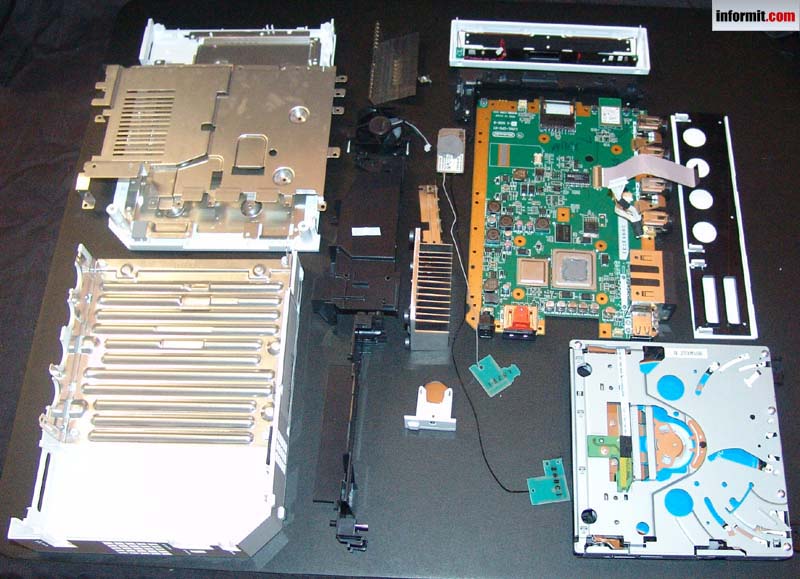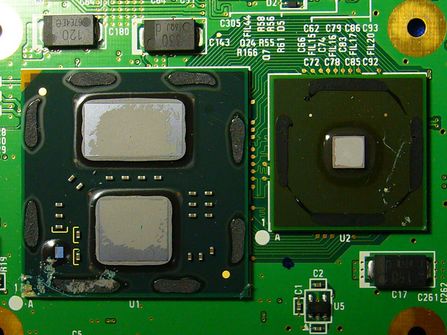You are using an out of date browser. It may not display this or other websites correctly.
You should upgrade or use an alternative browser.
You should upgrade or use an alternative browser.
Questions about the Broadway CPU
- Thread starter Flux
- Start date
I would be shocked if Broadway could pull off 48GFLOPs, even in Single Precision. A single-core CPU clocked at 730MHz is more likely to be pumping out 4.8GFLOPs than 48GFLOPs.
I would be shocked if Broadway could pull off 48GFLOPs, even in Single Precision. A single-core CPU clocked at 730MHz is more likely to be pumping out 4.8GFLOPs than 48GFLOPs.
Wasn't the Gamecube like 9.4-10GFLOPs?
It just had a little 485 MHz low-cost PowerPC G3 variant (750CXe) with some basic SIMD capabilties. One site says ~ 1.94 GFLOPS (4 floating point ops per clock). Probably a unlikely peak. It's not really a stunningly robust little CPU. Simple, very cheap and yet fairly effective.
As for Broadway, well who knows. The fact that it's very, very tiny though and clocked so low tells me that it's probably just about the same thing but on a smaller process.
As for Broadway, well who knows. The fact that it's very, very tiny though and clocked so low tells me that it's probably just about the same thing but on a smaller process.
Last edited by a moderator:
Vitaly Vidmirov
Newcomer
Wasn't the Gamecube like 9.4-10GFLOPs?
http://en.wikipedia.org/wiki/Nintendo_GameCube#Hardware_specifications
486MHz * 2 MADD per cycle = 1944 MFlops
It's not really a stunningly robust little CPU.
It's really stunningly robust, especially when you compare it to it's 4.4x higher clocked, but brain-damaged PowerPC brethren.
I'm guessing the Broadway's FP performance is 1.5x the Cube's FP performance, for obvious reasons.
Color me Dan
Regular
Why is it the only 64bit G3?
What do you mean by this quote if I may ask? Again i'm no expert but I wasn't aware the G3 was 64bit, if it was wouldn't that increase memory handling efficiency dramatically compared to GC? Well, overall performance too in alot of tasks I guess.
The Wii GPU is still a mystery is it?
What do you mean by this quote if I may ask? Again i'm no expert but I wasn't aware the G3 was 64bit, if it was wouldn't that increase memory handling efficiency dramatically compared to GC? Well, overall performance too in alot of tasks I guess.
The Wii GPU is still a mystery is it?
The G3 family of processors are 32-bit, using the usual definitions of these things outside console space. 32 vs 64-bitness has no bearing whatsoever on the CPU in the Wii, 64-bit pointers is not likely to be high up on the "desired features" list.
The Wii GPU is still a mystery insofar as no tech docs have been leaked, and the chip is far too large to be just a die shrink of the GC GPU.
While the cost conciousness of Nintendo implies that the die area isn't there without reason, those reasons aren't out in the wild yet. Developers have been mentioning things that imply that fillrates have increased more than clocks, but that's as far as it goes at this point in time.
Early development kits almost certainly used higher clocked GC GPUs in order to get development started and the Wii remote into the hands of developing houses. All early development took place on GC generation hardware/software assets. Still, we haven't any indication that the Wii GPU includes new programmability features, indeed all interviews made point towards the same basic pipeline as in the GC being in place.
This thread was about the CPU though, and IBM has published a pdf on it. It is a very decent performer for its power draw and process technology. Not a theoretical GFLOPS monster, but that doesn't seem to hurt it much in real life. Furthermore, it is surrounded by a pretty sympathetic memory subsystem for its processing power. Since it is so small, and draws so little power already, I'm not sure Nintendo will ever bother to move it down to finer lithography.
if it was [64bit] wouldn't that increase memory handling efficiency dramatically compared to GC? Well, overall performance too in alot of tasks I guess.
Well, no and no. 64-bit addressing allows for a larger memory but that's irrelevant here. It doesn't increase memory efficiency as such. As to performance, 64-bit operands consume more cache space and bandwidth; while having them doesn't do much anything for performance. (Unless you really need to crunch big numbers. SIMD is a different matter but it typically uses FP registers anyway, so doesn't relate to a CPU's "bitness".)
64-bitness when you don't need the big values just costs you bandwidth, cache capacity, and lots of transistors.
If you got the performance increase idea from AMD64, there it happened mostly because AMD64 added new registers to the desperately register-starved 386 baseline, not for the 64-bitness as such.
Last edited by a moderator:
Well, no and no. 64-bit addressing allows for a larger memory but that's irrelevant here. It doesn't increase memory efficiency as such. As to performance, 64-bit operands consume more cache space and bandwidth; while having them doesn't do much anything for performance. (Unless you really need to crunch big numbers. SIMD is a different matter but it typically uses FP registers anyway, so doesn't relate to a CPU's "bitness".)
64-bitness when you don't need the big values just costs you bandwidth, cache capacity, and lots of transistors.
If you got the performance increase idea from AMD64, there it happened mostly because AMD64 added new registers to the desperately register-starved 386 baseline, not for the 64-bitness as such.
If so what was the point of making Broadway a 64 bit chip instead of a 32bit chip?
It just had a little 485 MHz low-cost PowerPC G3 variant (750CXe) with some basic SIMD capabilties. One site says ~ 1.94 GFLOPS (4 floating point ops per clock). Probably a unlikely peak. It's not really a stunningly robust little CPU. Simple, very cheap and yet fairly effective.
As for Broadway, well who knows. The fact that it's very, very tiny though and clocked so low tells me that it's probably just about the same thing but on a smaller process.
The SIMD unit is the same one that is in the Xbox360's PPEs. 128 bit SIMD unit.
If so what was the point of making Broadway a 64 bit chip instead of a 32bit chip?
For one thing, IBM hasn't had a 32-bit processor since before Power3.
Color me Dan
Regular
Thank you for that thurough answer Entropy, I wasn't aiming at comparing 32bit to 64bit though so no worries there. Both have their strenghts and weaknesses in relation to their tasks. No, I got a bit confused by Flux's first post and thought I had to ask (in no way an insult to you Flux).
Broadway is not a direct decendant of Gekko but related to it as I understand it from reading about it on Wikipedia. If there is anyone with more knowledge about it's internals compared to Gekko i'd be very happy to hear about it.
Broadway is not a direct decendant of Gekko but related to it as I understand it from reading about it on Wikipedia. If there is anyone with more knowledge about it's internals compared to Gekko i'd be very happy to hear about it.
Just remember that Wikipedia is a warground for "edit wars" on "hot" topics such as new-ish consoles. You get lots of wishfully-thinking fanboy posts over there. They don't know more than some of the folks there, that's for sure.
Consider that Wii is backwards compatible with Cube so thoroughly that its hardware can probably only be a descendent of GC. It doesn't have anywhere near the performance to emulate a Cube, but it plays such games as well as its predecessor. Its system architecture certainly is reminiscent of Cube just from looking at the machine's RAM layout.
Consider that Wii is backwards compatible with Cube so thoroughly that its hardware can probably only be a descendent of GC. It doesn't have anywhere near the performance to emulate a Cube, but it plays such games as well as its predecessor. Its system architecture certainly is reminiscent of Cube just from looking at the machine's RAM layout.
The SIMD unit is the same one that is in the Xbox360's PPEs. 128 bit SIMD unit.
Not true.
Not true.
Right. Here's why:
Source
IBM Paper said:While the term VMX is familiar to PowerPC users, the implementation on the Xbox 360 processor is a new design called VMX128 which was specially enhanced to accelerate 3D graphics and game physics.
The number of vector registers was increased from 32 to 128. All 128 registers are directly addressable, and the original 32 registers are mapped to the first 32 entries of 128-entry vector register file, and so are compatible with the original PowerPC ISA. We also added a number of new instructions. Instructions were added to calculate the dot-product of two vectors made from three or four floating point values. Data formatting instructions were added to help improve the processing of data that has been packed into memory to reduce the program size. These include: instructions for rotate and insert operations, pack/unpack instructions for handling Direct3D® data types, and loads and stores for misaligned data. The VMX128 ISA is binary-compatible with a subset of VMX. A few vector floating point and vector integer instructions are no longer supported, and attempting to execute them will result in the system illegal instruction handler being invoked.
Color me Dan
Regular
Just remember that Wikipedia is a warground for "edit wars" on "hot" topics such as new-ish consoles. You get lots of wishfully-thinking fanboy posts over there. They don't know more than some of the folks there, that's for sure.
Hehe, Very true. But it does give you a general idea of things. I really hope we will get to know details soon, not because I think it makes a difference but because it is teasing my mind that we don't.
IBM PowerPC 750CL Microprocessor PDFI really hope we will get to know details soon, not because I think it makes a difference but because it is teasing my mind that we don't.
http://www.eembc.com/Press/PressRelease/070314.htm
http://blog.newsweek.com/blogs/leve...amecube-one-point-five-yes-says-beyond3d.aspxThe IBM PowerPC 750CL RISC microprocessor is a 32-bit implementation of the IBM PowerPC family and operates at speeds from 400 MHz to 1 GHz. The 750CL includes a 256KB L2 cache and is targeted at networking, storage, imaging, consumer electronic, and other high-performance embedded applications.
Broadway, the Wii's CPU, is a derivative of the PowerPC 750 CL clocked at 729Mhz. It is fully backwards compatible with the Gekko, the GameCube's CPU, which was clocked at 485Mhz. Hollywood is connected to main memory by a 64-bit bus clocked at 243Mhz, which results in 1.9GB/s of memory bandwidth. The processor is built on a 90 nanometer process and measures 18.9 mm2, slightly larger than the PowerPC 750 CL. Furthermore, it contains two separate eight-way associative L1 caches, one for instructions and one for data, as well as a 256KB two-way associative L2 cache. Finally, the chip is powered by one floating-point and two fixed-point units, which are capable of both single and double precision arithmetic.


Note how incredibly tiny the "Broadway" CPU die (right) is.
Last edited by a moderator:
Similar threads
- Replies
- 34
- Views
- 4K
- Replies
- 21
- Views
- 3K
- Replies
- 66
- Views
- 3K
- Replies
- 26
- Views
- 3K
- Replies
- 102
- Views
- 15K
